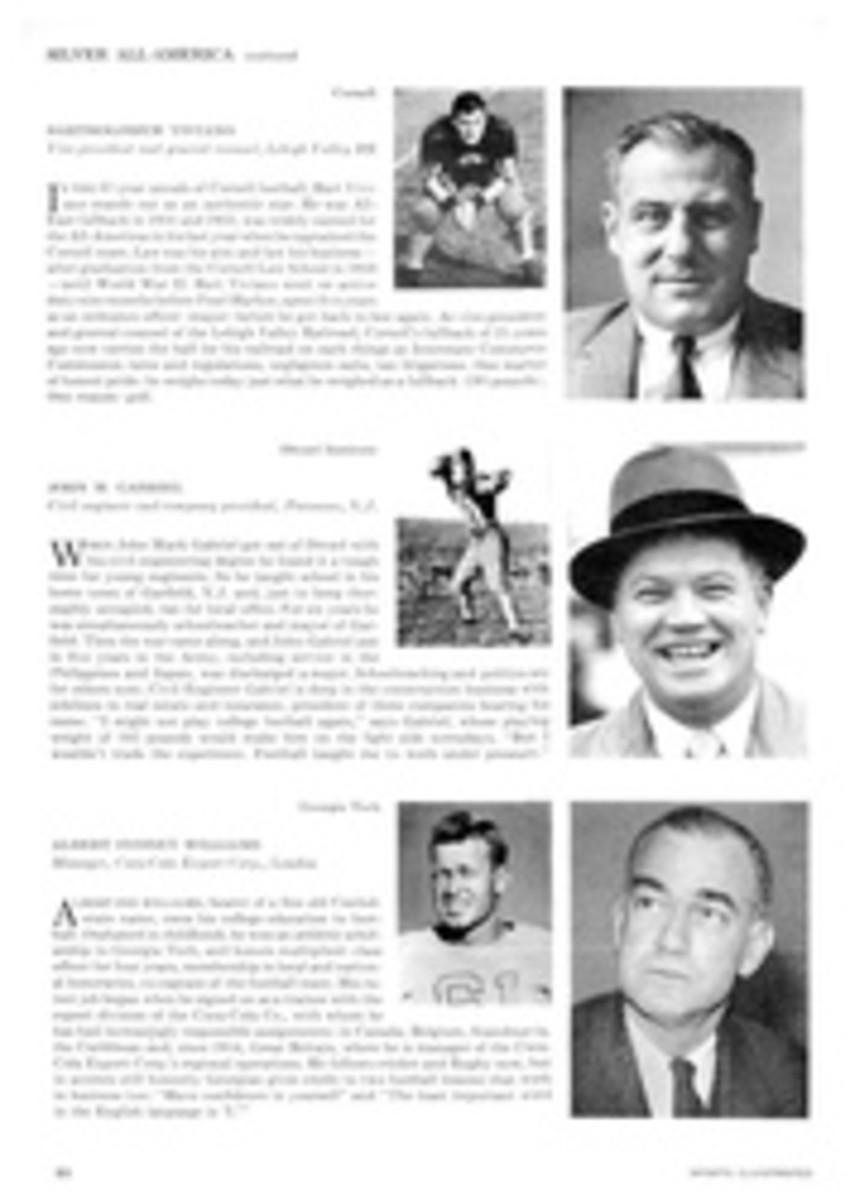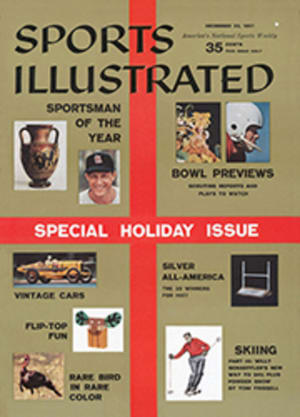
A FINAL ACCOUNTING
Never before in the history of intercollegiate football has form taken such a beating as it did during the 1957 season. With this in mind I contacted 25 leading coaches around the country for their explanation of why so many upsets. The succinct answer of UCLA's "Red" Sanders really made me laugh. "I'll be damned if I know," he wired.
To a man the coaches agreed that the principal reason for this topsy-turvy season was a better balance of material among the major colleges. Other factors were the now almost universal practice of studying motion pictures of opponents' games, better coaching everywhere, the Asiatic flu epidemic which crippled many teams from one to three weeks and, of course, the ever-present psychological angle.
Terry Brennan, whose Notre Dame pulled the upset of many seasons by ending Oklahoma's fantastic winning streak, said: "A possible explanation is that a particular team decides they are going out to do the job on a given day and just will not be denied."
Duffy Daugherty came close to going all the way with his great Michigan State squad, losing only to Purdue. He explains the loss this way: "With our desire to do well we were over-anxious and made too many mistakes." Incidentally, Eddie Erdelatz at Navy feels that he had his team much too "tight" in their game with North Carolina and blames himself for this upset.
Jim Tatum of North Carolina figured in the form reversals almost more than anyone, particularly on the day his boys upset their archrival, Duke. Then he proceeded to lose the following week to a so-so Virginia team. Tatum had this to say: "Only 20 days of spring practice is beginning to show in the fall performance. More mistakes are being made. We won five games when we were the underdogs, won one game when we were favored, lost three when we were favored and one when we were underdogs. Sophomores made outstanding plays one Saturday and outstanding mistakes the next."
Many interesting trends showed up this year. More emphasis was placed on defense than ever before. Tight defenses with eight-and nine-man fronts were the order of the day emerging from 5-4 or 4-4 alignments immediately before the ball was snapped. Stunting and "jitterbugging" (backers-up moving in and out of the line while the starting signals were being called) made it tougher than ever for the offense to play "possession" football.
Most of the successful teams varied their offense slightly from week to week. Most repertoires included balanced line, unbalanced line to either side, split ends, men-in-motion, plus a combination of the tight T and split-T to keep the defense guessing. Mass defenses forced the split-T adherents to forsake much of their inside attack and attempt the halfback run or pass option to either side. Because of the defensive stress, greater value was placed on position on the field; the kicking game in all its phases, particularly the quick-kick, became an important adjunct to the offensive scheme and not just a fourth-down last resort.
Few teams ran true to preseason predictions in this hectic season. Among those that finished at or near the top—as originally predicted—were Navy, Michigan State, Iowa, Oklahoma, Oregon State, Utah, Princeton and Arizona State (Tempe). Little-known Arizona State, along with Auburn, was the only undefeated, untied major team in the country. Incidentally, Coach Dan Devine has a three-year record in this tough Border Conference of 27 wins, 3 losses and one tie.
I can't remember a year when there were more outstanding linemen, but possibly the accent on defense was responsible. Tackle Lou Michaels, on Kentucky's singularly unsuccessful team, was the most spectacular. He wrecked Tennessee completely for the Wildcats' only conference win. In this one game here were some of his deeds. Michaels recovered one Vol fumble for a touchdown, stole another which led to a second score, did the punting, kicked two extra points and made tackles all over the field. Others in the same class, if not as spectacular, were End Pete Jokanovich and Tackle Bob Reifsnyder of Navy, End Jimmy Phillips of Auburn, Center Dan Currie of Michigan State, Tackle Alex Karras of Iowa, End Dick Wallen of UCLA and Guard Bill Krisher of Oklahoma.
In the backfield Dick Christy of North Carolina State was the most sensational. Outstanding T quarterbacks were Dick Winterbauer of Yale, Lee Grosscup of Utah, King Hill of Rice and Tom Forrestal of Navy. Great runners, excellent blockers and stern defensively were Walt Kowalczyk of Michigan State, John Crow of Texas A&M and Don Clark of Ohio State.
So ends a most exciting season. It will be a short winter for the winning coaches, but what about the losers? The smart ones will get ahead of the mob as they are being run out of town and act like they're leading a parade.
ILLUSTRATION
ELEVEN BEST ELEVENS OF 1957
ARIZONA STATE
AUBURN
IOWA
MICHIGAN STATE
MISSISSIPPI
NAVY
NOTRE DAME
OHIO STATE
OKLAHOMA
RICE
TEXAS
INDIVIDUAL PERFORMANCES
TOTAL OFFENSE LEADER: Bob Newman, Washington St., 1,444 yds.
LEADING GROUND-GAINER: Leon Burton, Arizona St., 1,126 yds.
LEADING PASSER: Ken Ford, Hardin-Simmons, 1,254 yds.
LEADING PASS RECEIVER: Stuart Vaughan, Utah, 756 yds.
LEADING PUNTER: Ken Hall, Idaho, 44.7 yds. per kick
TEAM PERFORMANCES
TOTAL OFFENSE LEADER: Arizona State, 444.9 yds. per game
RUSHING LEADER: Colorado, 322 yds. per game
PASSING LEADER: Utah, 195 yds. per game
TOTAL DEFENSE LEADER: Auburn, 133 yds. per game
PASS-DEFENSE LEADER: Georgia Tech, 33.4 yds. per game
GROUND-DEFENSE LEADER: Auburn, 67 yds. per game

